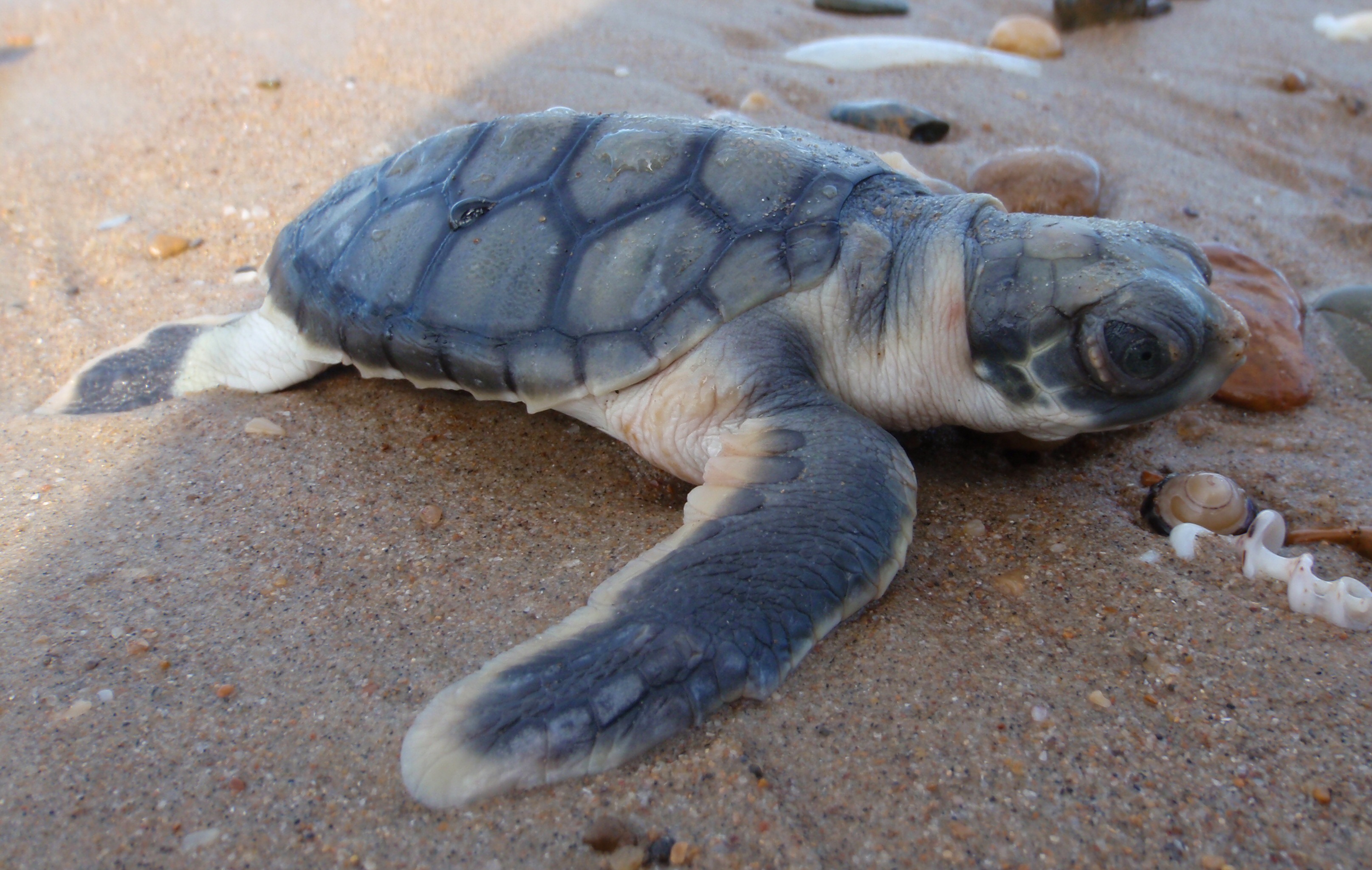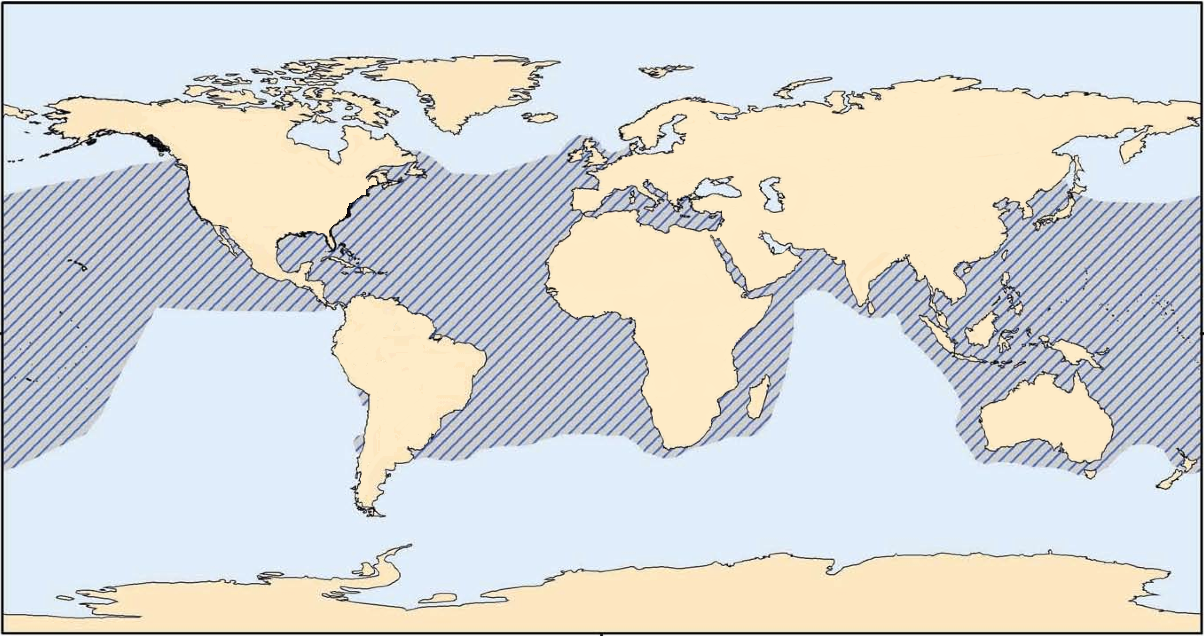|
Carettinae
Cheloniidae is a family of typically large marine turtles that are characterised by their common traits such as, having a flat streamlined wide and rounded shell and almost paddle-like flippers for their forelimbs. They are the only sea turtles to have stronger front limbs than back limbs. The six species that make up this family are: the green sea turtle, loggerhead sea turtle, olive ridley sea turtle, hawksbill sea turtle, flatback sea turtle and the Kemp's ridley sea turtle. Morphology In contrast to their earth-bound relatives, tortoises, sea turtles do not have the ability to retract their heads into their shells. Their plastron, which is the bony plate making up the underside of a turtle or tortoise's shell, is comparably more reduced from other turtle species and is connected to the top part of the shell by ligaments without a hinge separating the pectoral and abdominal plates of the plastron. Sizes among the seven species of sea turtles range from 71 to 213 cm; for e ... [...More Info...] [...Related Items...] OR: [Wikipedia] [Google] [Baidu] |
Late Cretaceous
The Late Cretaceous (100.5–66 Ma) is the more recent of two epochs into which the Cretaceous Period is divided in the geologic time scale. Rock strata from this epoch form the Upper Cretaceous Series. The Cretaceous is named after ''creta'', the Latin word for the white limestone known as chalk. The chalk of northern France and the white cliffs of south-eastern England date from the Cretaceous Period. Climate During the Late Cretaceous, the climate was warmer than present, although throughout the period a cooling trend is evident. The tropics became restricted to equatorial regions and northern latitudes experienced markedly more seasonal climatic conditions. Geography Due to plate tectonics, the Americas were gradually moving westward, causing the Atlantic Ocean to expand. The Western Interior Seaway divided North America into eastern and western halves; Appalachia and Laramidia. India maintained a northward course towards Asia. In the Southern Hemisphere, Aus ... [...More Info...] [...Related Items...] OR: [Wikipedia] [Google] [Baidu] |
Sea Turtle
Sea turtles (superfamily Chelonioidea), sometimes called marine turtles, are reptiles of the order Testudines and of the suborder Cryptodira. The seven existing species of sea turtles are the flatback, green, hawksbill, leatherback, loggerhead, Kemp's ridley, and olive ridley. Six of the seven sea turtle species, all but the flatback, are present in U.S. waters, and are listed as endangered and/or threatened under the Endangered Species Act. They are listed as threatened with extinction globally on the IUCN Red List of Threatened Species. The flatback turtle is found only in the waters of Australia, Papua New Guinea, and Indonesia. Sea turtles can be categorized as hard-shelled ( cheloniid) or leathery-shelled ( dermochelyid).Wyneken, J. 2001. The Anatomy of Sea Turtles. U.S Department of Commerce NOAA Technical Memorandum NMFS-SEFSC-470, 1-172 pp. The only dermochelyid species of sea turtle is the leatherback. Description For each of the seven species of sea turtles, ... [...More Info...] [...Related Items...] OR: [Wikipedia] [Google] [Baidu] |
Cladogram
A cladogram (from Greek language, Greek ''clados'' "branch" and ''gramma'' "character") is a diagram used in cladistics to show relations among organisms. A cladogram is not, however, an Phylogenetic tree, evolutionary tree because it does not show how ancestors are related to descendants, nor does it show how much they have changed, so many differing evolutionary trees can be consistent with the same cladogram. A cladogram uses lines that branch off in different directions ending at a clade, a group of organisms with a last common ancestor. There are many shapes of cladograms but they all have lines that branch off from other lines. The lines can be traced back to where they branch off. These branching off points represent a hypothetical ancestor (not an actual entity) which can be inferred to exhibit the traits shared among the terminal taxa above it. This hypothetical ancestor might then provide clues about the order of evolution of various features, adaptation, and other e ... [...More Info...] [...Related Items...] OR: [Wikipedia] [Google] [Baidu] |
Flatback Sea Turtle
The Australian flatback sea turtle (''Natator depressus'') is a species of sea turtle in the Family (biology), family Cheloniidae. The species is Endemism, endemic to the sandy beaches and shallow coastal waters of the Australian continental shelf. This turtle gets its common name from the fact that its shell has a flattened, lower dome than the other sea turtles. It can be olive green to grey with a cream underside. It averages from in carapace length and can weigh from . The hatchlings are larger than other sea turtle hatchlings when they hatch and emerge from their nests. The flatback turtle is listed by the IUCN Red List of Threatened Species as data deficient, meaning there is insufficient scientific information to determine its conservation status at this time. It was previously listed as vulnerable in 1994. It is not as threatened as other sea turtles due to its small dispersal range. This animal can be 31 to 37 inches long and about 100 kg in weight. Taxonomy The ... [...More Info...] [...Related Items...] OR: [Wikipedia] [Google] [Baidu] |
Natator
The Australian flatback sea turtle (''Natator depressus'') is a species of sea turtle in the family Cheloniidae. The species is endemic to the sandy beaches and shallow coastal waters of the Australian continental shelf. This turtle gets its common name from the fact that its shell has a flattened, lower dome than the other sea turtles. It can be olive green to grey with a cream underside. It averages from in carapace length and can weigh from . The hatchlings are larger than other sea turtle hatchlings when they hatch and emerge from their nests. The flatback turtle is listed by the IUCN Red List of Threatened Species as data deficient, meaning there is insufficient scientific information to determine its conservation status at this time. It was previously listed as vulnerable in 1994. It is not as threatened as other sea turtles due to its small dispersal range. This animal can be 31 to 37 inches long and about 100 kg in weight. Taxonomy The flatback sea turtle is the s ... [...More Info...] [...Related Items...] OR: [Wikipedia] [Google] [Baidu] |
Hawksbill Sea Turtle
The hawksbill sea turtle (''Eretmochelys imbricata'') is a critically endangered sea turtle belonging to the family Cheloniidae. It is the only extant species in the genus ''Eretmochelys''. The species has a global distribution that is largely limited to tropical and subtropical marine and estuary ecosystems. The appearance of the hawksbill is similar to that of other marine turtles. In general, it has a flattened body shape, a protective carapace, and flipper-like limbs, adapted for swimming in the open ocean. ''E. imbricata'' is easily distinguished from other sea turtles by its sharp, curving beak with prominent tomium, and the saw-like appearance of its shell margins. Hawksbill shells slightly change colors, depending on water temperature. While this turtle lives part of its life in the open ocean, it spends more time in shallow lagoons and coral reefs. The World Conservation Union, primarily as a result of human fishing practices, classifies ''E. imbricata'' as crit ... [...More Info...] [...Related Items...] OR: [Wikipedia] [Google] [Baidu] |
Eretmochelys
The hawksbill sea turtle (''Eretmochelys imbricata'') is a critically endangered sea turtle belonging to the family Cheloniidae. It is the only extant species in the genus ''Eretmochelys''. The species has a global distribution that is largely limited to tropical and subtropical marine and estuary ecosystems. The appearance of the hawksbill is similar to that of other marine turtles. In general, it has a flattened body shape, a protective carapace, and flipper-like limbs, adapted for swimming in the open ocean. ''E. imbricata'' is easily distinguished from other sea turtles by its sharp, curving beak with prominent tomium, and the saw-like appearance of its shell margins. Hawksbill shells slightly change colors, depending on water temperature. While this turtle lives part of its life in the open ocean, it spends more time in shallow lagoons and coral reefs. The World Conservation Union, primarily as a result of human fishing practices, classifies ''E. imbricata'' as critica ... [...More Info...] [...Related Items...] OR: [Wikipedia] [Google] [Baidu] |
Cheloniinae
Cheloniinae is a subfamily of the sea turtle family (biology), family Cheloniidae. Its parent Taxonomic rank, superfamily is Chelonioidea. The members of the subfamily, and genus, genera that make it up, are: External links * http://home.earthlink.net/~itec5/Testudinata/ Cheloniidae {{turtle-stub ... [...More Info...] [...Related Items...] OR: [Wikipedia] [Google] [Baidu] |
Olive Ridley Sea Turtle
The olive ridley sea turtle (''Lepidochelys olivacea''), also known commonly as the Pacific ridley sea turtle, is a species of turtle in the family Cheloniidae. The species is the second-smallest and most abundant of all sea turtles found in the world. ''L. olivacea'' is found in warm and tropical waters, primarily in the Pacific and Indian Oceans, but also in the warm waters of the Atlantic Ocean. This turtle and the related Kemp's ridley sea turtle are best known for their unique synchronised mass nestings called ''arribadas'', where thousands of females come together on the same beach to lay eggs. Taxonomy The olive ridley sea turtle may have been first described as ''Testudo mydas minor'' by Georg Adolf Suckow in 1798. It was later described and named ''Chelonia multiscutata'' by Heinrich Kuhl in 1820. Still later, it was described and named ''Chelonia olivacea'' by Johann Friedrich von Eschscholtz in 1829. The species was placed in the subgenus ''Lepidochelys'' by ... [...More Info...] [...Related Items...] OR: [Wikipedia] [Google] [Baidu] |
Loggerhead Sea Turtle
The loggerhead sea turtle (''Caretta caretta'') is a species of sea turtle, oceanic turtle distributed throughout the world. It is a marine reptile, belonging to the Family (biology), family Cheloniidae. The average loggerhead measures around in carapace length when fully grown. The adult loggerhead sea turtle weighs approximately , with the largest specimens weighing in at more than . The skin ranges from yellow to brown in color, and the shell is typically reddish brown. No external differences in sex are seen until the turtle becomes an adult, the most obvious difference being the adult males have thicker tails and shorter plastrons (lower shells) than the females. The loggerhead sea turtle is found in the Atlantic Ocean, Atlantic, Pacific Ocean, Pacific, and Indian Oceans, as well as the Mediterranean Sea. It spends most of its life in saltwater and estuarine habitats, with females briefly coming ashore to lay eggs. The loggerhead sea turtle has a low reproductive rate; fem ... [...More Info...] [...Related Items...] OR: [Wikipedia] [Google] [Baidu] |







